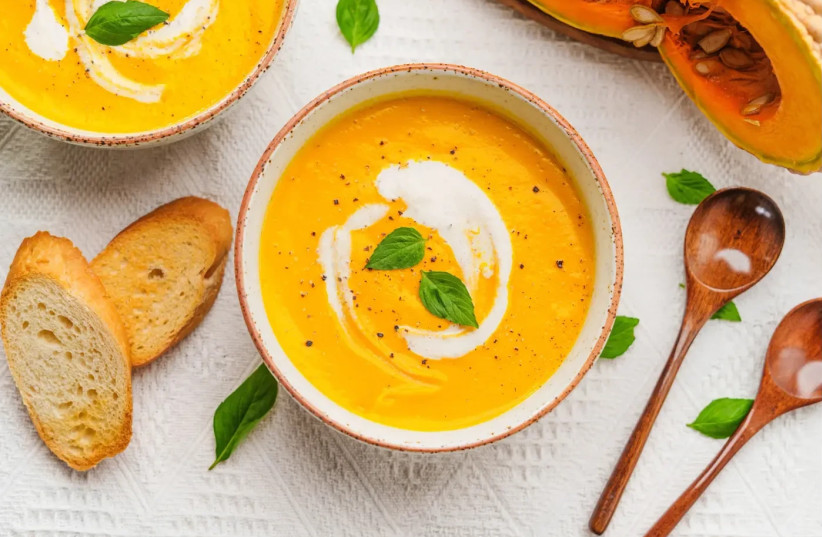Jerusalem Post
ByDR. MAYA ROSMAN
We call them pumpkin – but in fact, it’s one orange family with quite a few varieties and plenty of health benefits. Here’s how eating pumpkin can help you lose weight.
It may remind us of scenes from movies with orange pumpkins, scary faces, and autumn nights – but beyond the symbolism, pumpkin is one of the healthiest and most versatile vegetables there is. It’s rich in vitamins, low in calories, and fits a variety of dishes, from soups to desserts. And now is its season.
But not all pumpkins are identical, and not all are called Pumpkin: Each type has a different taste, texture, and nutritional value.
Pumpkin comes in a wide range of types, each with slightly different flavors, textures, and nutritional values. Despite the differences, all are low in calories (an average of 35–45 calories per 100 grams) and contain beta-carotene – the orange pigment, which is also an important antioxidant that the body converts into vitamin A, essential for vision, the immune system, and skin health.
Recent studies published in the Journal of Nutrition have shown that consuming orange foods rich in beta-carotene, such as pumpkin, is linked to a lower risk of heart disease and lung cancer.
Butternut Squash
The butternut squash is perhaps the most popular in Israel – its flavor is sweet, its texture soft and velvety, and it blends perfectly into any winter recipe.
Nutritionally, it is particularly rich in vitamin A (over 350% of the daily recommended intake per 100 grams cooked), vitamin C, potassium, dietary fiber, and antioxidants.
A study published in Food Chemistry found that butternut squash extract had exceptionally high antioxidant activity and helped reduce inflammation in the body.
Acorn Squash
It has a milder flavor, contains slightly more calories (about 55 calories per 100 grams) due to its higher carbohydrate content.
It’s rich in vitamin C, calcium, magnesium, and folic acid, and it’s one of the few pumpkins that contain significant amounts of vitamin B6, essential for metabolism and nervous system function.
According to a study published in Plant Foods for Human Nutrition, adding acorn squash to the daily diet contributed to a reduction in blood pressure levels in people with mild hypertension.
Spaghetti Squash
Unique in that after cooking, its contents separate into “strings” resembling noodles – a natural solution for anyone seeking a pasta alternative.
It is very low in calories: Only 25 calories per 100 grams, and rich in vitamin C, fiber, and potassium. Due to its extremely low caloric density, it can help maintain a feeling of fullness for longer and balance blood sugar levels.
Less common in Israel, but the Japanese pumpkin is sweet with a texture reminiscent of sweet potato. It contains an especially high concentration of beta-carotene, along with vitamin E and niacin (B3). The combination of these antioxidants has been proven in studies from Japan (Journal of Agricultural and Food Chemistry) to help reduce oxidative damage to skin cells and improve elasticity.
Regular Pumpkin
Our classic pumpkin – and the one used for Halloween. Very low in calories (about 30 calories per 100 grams) but particularly rich in antioxidants. According to Moshe Saadon, with whom I spoke on my radio show yesterday, such a pumpkin takes about six months to reach full size, and some pumpkins can weigh more than 100 kg.
Studies in Nutrients have shown that regular pumpkin extract helps improve blood sugar levels and maintain proper pancreatic function.
It also contains vitamin C, potassium, and zinc, which strengthen the immune system, especially during the changing seasons.
Pumpkin seeds themselves provide an excellent source of healthy fats, zinc, and iron – you can roast them instead of throwing them away.
Summary of the Nutritional Values of the Pumpkin Family
Vitamin A (Beta-Carotene): The star ingredient: 100 grams of cooked pumpkin contain over 8,000 IU – more than 100% of the recommended daily intake. Essential for vision, skin, and the immune system.
Vitamin C: Strengthens the immune system and contributes to collagen production for skin and tissues. In 100 grams of pumpkin, there are about 9 mg of vitamin C, which is roughly 15% of the daily requirement for adults.
B Vitamins: Mainly B6 and B9 (folic acid), important for nerve function and metabolism.
Potassium: Helps regulate blood pressure and reduce the risk of heart disease.
Dietary Fiber: Supports healthy digestion, prolongs satiety, and helps balance blood sugar levels.
Natural Antioxidants: Protect cells from oxidative damage and slow down aging processes.
Calories: On average, only about 40 calories per 100 grams cooked, making pumpkin an ideal ingredient for any healthy or diet menu.
What to Do with Pumpkin?
Pumpkin is a versatile vegetable that suits both savory and sweet dishes. Here’s a reminder of some tasty ways to include it in your menu:
Pumpkin Soups:
You can make a creamy soup seasoned with cinnamon and ginger or a savory version with garlic and spicy seasonings.
Adds natural sweetness and a rich texture to dishes with legumes, meat, or whole grains.
Pasta Substitute:
Spaghetti squash pairs beautifully with tomato or cream sauces as a pasta alternative.
Baked Goods and Pies:
You can include pumpkin in pies or both savory and sweet pastries.
Healthy Desserts:
Pumpkin pie, cakes, pancakes, and even smoothies! You can add cooked pumpkin to a protein shake or moist cake recipes.
Pumpkin Seeds:
An excellent source of protein, magnesium, and healthy fatty acids. You can roast them and add to salads or enjoy as a healthy snack.
Roasted Pumpkin Salad:
I tried it – and it’s amazing. A salad of fresh baby leaves, sprouts, cherry tomatoes, and cubes of roasted pumpkin (in some pumpkin varieties, you can even leave the peel on).


















